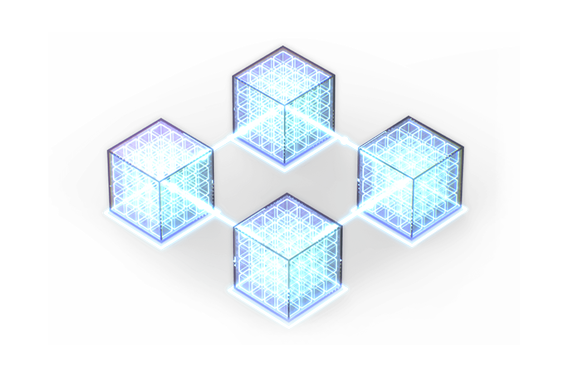Blockchain
What is Blockchain?
Blockchain technology, which underpins digital currencies, assets, and commodities, can be defined as a distributed database or shared ledger updated through consensus. However, blockchain possesses a power beyond that of a regular database.
A blockchain network can be either public or private. If it operates on a schema where anyone can read, use, or modify, it is known as a "Public Blockchain." If the system provides limited and controlled access, it is referred to as a "Private Blockchain."
For more information on blockchain, you can visit the official website of the BAĞ system.

Asset Transfer
Public and Private Keys: Each user in the blockchain system has a pair of keys when they participate. The public key can be known by everyone and represents the user's public account on the blockchain. The private key, on the other hand, is carefully kept by the user and is unknown to anyone else. The private key is used to sign and verify transactions.
Transaction Creation: When a user wants to transfer assets to another user, they create a transaction. This transaction contains the amount of the asset to be sent and the recipient's public key. For example, User 0 initiates this transaction when they want to send a valuable asset (digital currency, commodity, etc.) from their account to User 1.
1. Transaction Summary Generation: The transaction generates a hash before being aggregated into a block. This hash combines the transactions, the previous block hash and the public key of the person to whom the transfer is to be made. The blocks are processed at regular intervals and records are stored in them. During this process, cryptographic hash algorithms and digital signatures are used.
2. Signature and Control: The signed transaction is sent to the blockchain network. The nodes in the network check the accuracy and validity of the transaction. The transaction verifies whether the sending user has sufficient assets and has not previously used the same asset in a previous transaction. At this stage, the signatory's public and private keys are used.
3. Confirmation and Addition to Blockchain: After a certain number of nodes have verified the transaction, it is added to the blockchain. This ensures that the transaction is permanently recorded. The transaction is engraved onto the blockchain using hash functions.
Blockchain Technologies
In today's digital world, data transfer occurs in various fields (multimedia, communication, web interfaces, etc.). Blockchain technology, however, is a distributed database that allows us to transfer assets we assign value to, beyond just data. The concept of a new international currency emerged alongside the introduction of Bitcoin, proposed by an anonymous author using the pseudonym Satoshi Nakamoto in 2008. While Bitcoin was initially perceived solely as a form of currency, it became evident that blockchain technology, from which Bitcoin originates, could have broader applications.
Blockchain technology fundamentally enables trust to be distributed, eliminating the need for a central server or a trusted authority. This technology, underlying digital currencies like Bitcoin and Ethereum, is not limited to financial applications but can be utilized across a wide spectrum of uses.
By replacing centralized trust systems, blockchain technology addresses one of the significant challenges faced by modern society. It not only facilitates the secure and transparent transfer of valuable assets alongside data transfer within the existing internet infrastructure but also opens doors to a new technology described as a decentralized, encrypted ledger that could reshape all aspects of our lives.
Blockchain Model
Blockchain technology is built upon a structure that integrates records and blocks. Here are the fundamental components that make up this structure:
Records: Blockchain records contain all kinds of content information created on top of the relevant blockchain structure. Depending on design requirements, these records can include currency transfers, asset records, customer information, and other values. Specifically for virtual currencies, these records hold information about currency transfer transactions. All transfers made from one registered user to another registered user in the system are kept through these records. New transfer requests are also queued and recorded during the next transaction, taking their place.
Blocks: Records are combined and processed into blocks at specific intervals. The criteria for the content of blocks and how many records they can hold are part of the blockchain design. Typically, cryptographic hash algorithms and digital signatures are used during the creation of a block. This is crucial to ensure the security and integrity of the blocks and represents the sequence of operations in which a new block is connected to the previous block and how the system is continually updated.
This structure forms the basic data structure that blockchain relies on. The sequential combination of records and their secure processing into blocks enables blockchain to function as a secure, transparent, and distributed ledger.
Centralized
Decentralized
Distributed
Hash Algorithms
Hash algorithms can be defined as follows without a technical explanation:
They are one-way functions that transform data of different lengths into a fixed length and produce the same output for the same input every time. These functions ensure that even a single character change in a text completely alters the text's hash. Hash functions are used to verify data integrity, making them of great importance in blockchain databases.
In blockchain, when block summaries are created, the summary value of the previous block is added to the new block. This creates a structure where blocks are linked to each other, and each block is connected through a hash algorithm to the previous and next blocks. These connections ensure the integrity and history of any block can be verified. This is why this technology is called "blockchain," which means "blocks linked together."
In blockchain technology, every participant retains a copy of all records from the beginning of the system. If records are altered, the hashes change, and this change can be detected by other participants. This eliminates the need for a trusted central database. Blockchain offers a distributed database system, where everyone can verify and trust the information, creating a transparent and reliable environment.
Blockchain technology emerged in 2009 with its initial application, Bitcoin, bringing together four distinct fields of science. While these four fields existed independently before, their convergence with Bitcoin led to a significant innovation, making Bitcoin revolutionary. Furthermore, it opened the doors for a broader range of applications for blockchain technology.
Economics and Monetary Theory
Bitcoin is closely related to economics and monetary theory. By creating a decentralized digital currency outside the traditional financial system and central banks, it established economic independence. Bitcoin's supply and demand dynamics are based on economic theory.
Database Theory
Blockchain redefined database theory. It replaced traditional centralized databases with a system where data is distributed and secured. This introduced an entirely new approach to databases.
Cryptography
Blockchain technology relies on cryptography.
Cryptography is used to secure data and supports the functioning of cryptocurrencies like Bitcoin. Cryptography plays a critical role in ensuring the security of user identities, transactions, and blocks.
Game Theory
The operation of Bitcoin is based on game theory, where players (miners) are incentivized, and the process of verifying transactions is competitive. Miners compete to verify transactions and create new blocks, which enhances the reliability of the system.
Wide Access Distributed Ledger
Permissionless Public Shared
Permissioned Public Shared
Permissioned Private Shared
Databases
Bitcoin & Ethereum's Impact on Blockchain
Bitcoin and Ethereum are two significant representatives of blockchain technology, each with its profound impact in their respective domains. While Bitcoin dominates the cryptocurrency space in terms of digital currencies (https://coinmarketcap.com/), Ethereum offers a broader range of functionalities through smart contracts. Ethereum provides a platform for implementing special transaction rules known as smart contracts. These contracts enable the execution of automated transactions and agreements through code. Ethereum can function like a global computer accessible to anyone worldwide, allowing a wider user base to access decentralized applications and services. While Bitcoin serves as a platform for a decentralized digital currency, Ethereum goes beyond by providing a platform for applications that can operate without the need for a trusted third party or centralized servers. With its logic of smart contracts, Ethereum has initiated a transformative process that has the potential to revolutionize existing internet technologies entirely.

- Do You Need Blockchain in Your Business Model?
- The Future of Blockchain Technology
Blockchain technology may not be suitable for every business model and use case. Therefore, it's essential to consider specific requirements and use cases before implementing blockchain. Here are some factors that can help you assess whether you need blockchain technology:
- Is Distributed Trust Needed?: Blockchain establishes trust in a distributed manner among multiple actors. If you don't have trust issues in your business model or have other mechanisms to ensure trust, blockchain usage may not be necessary.
- Are There Multiple Parties Generating and Using Data?: Blockchain eliminates the need for a central authority by providing trust among multiple parties. If data generation and usage in your business are carried out by a single centralized actor, blockchain may not be needed.
- Is There a Need for Data Immutability?: Blockchain makes it challenging to alter data. If data records' immutability is not a significant concern for your business, blockchain may not be required.
- Is Privacy Important?: Blockchain technology can provide different levels of privacy. However, some applications may require more privacy and blockchain may be limited in this case.
- Is There a Need for Central Authority?: Blockchain enables transactions to occur without the need for a central authority. If your business model doesn't involve a central institution or authority, blockchain could be considered.
- Is Audit Needed?: Blockchain transparently records transactions and provides auditing capabilities. If your business necessitates auditing, blockchain might be a suitable choice.
In conclusion, blockchain technology can offer numerous benefits under specific conditions. However, it's essential to remember that it's not suitable for every business model. The decision to use blockchain or not should be based on your business model's needs and objectives.
Bitcoin altyapısını oluşturan blokzincir teknolojisi gelecek vadeden bir teknoloji olmakla beraber bu teknolojinin tam bir olgunluğa erişmesi için kat edilmesi gereken adımlar vardır. Ancak, İsviçre merkezli Credit Suisse tarafından hazırlanan geniş çaplı bir rapora göre, blokzincir sadece dijital para birimleri veya finansal hizmetler için değil birçok alanda kullanılmaktadır. Dünya Ekonomik Forumu tarafından yapılan bir ankete göre, yöneticilerin %58’i küresel Gayri Safi Millî Üretimin %10’unun “2025’den önce blokzincirde bulunacağı” yönünde bir tahmin yürütmektedir. Bu yıl rapora göre olgunluğa erişim yılı olarak belirtilmiştir. Şu anda bu teknoloji prototip ve deney aşamalarının arasında yer almaktadır.
Observers of the market expect specific products developed in 2018 to become frequently mentioned, anticipating the emergence of providers and new models. In 2017, many blockchain partnerships were formed. For example, in financial services, banks initiated joint ventures to test blockchain technology. In December, UBS signed agreements with a series of banks in Europe to test blockchain technology. They will trust the accuracy of their data to blockchain technology instead of relying on a third party or institution to review their data. According to this bank, blockchain technology will benefit not only in financial services but also in other areas. Credit Suisse stated that in 2017, other companies operating in various fields, such as consumer products and manufacturing, implemented blockchain solutions. It has been emphasized by the bank that 2018 will be a critical year for blockchain technology.

